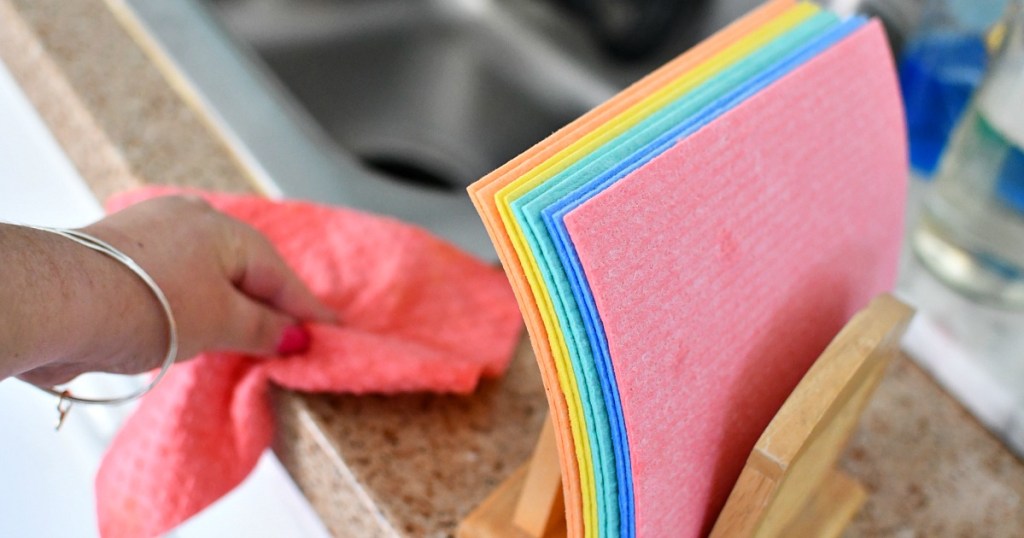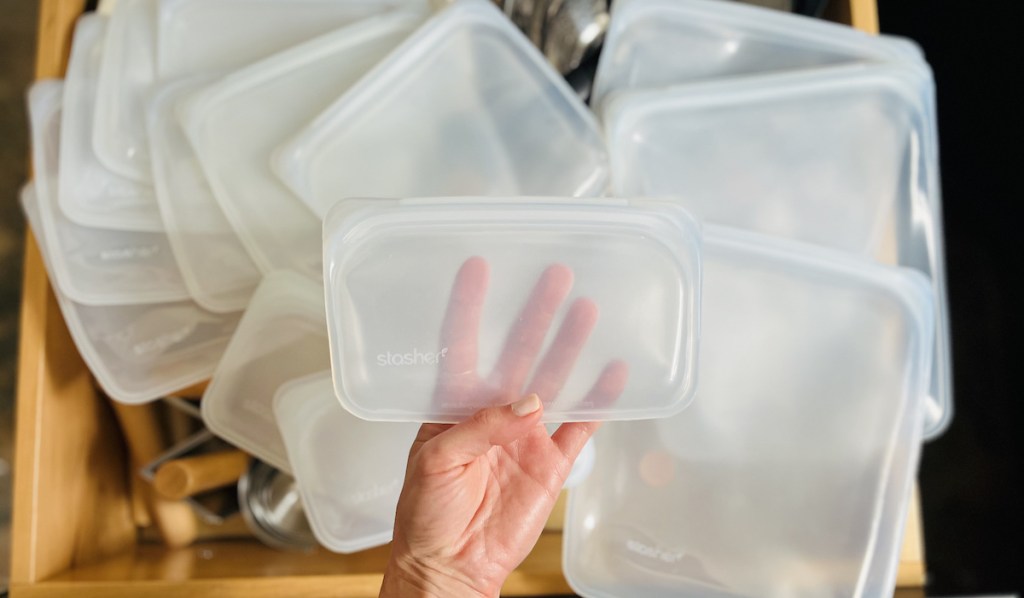Save money and the planet with these eco friendly products and sustainable products for you and your home.

There’s more than one way to save money & the planet. 🙌🏻
Stop buying these products and opt for these sustainable products & eco friendly products instead! Your home, body, & wallet will thank you.
With April being Earth Month, there’s no better time to stock up or try some new eco friendly products! Be sure to check for Earth Day sales on or around Saturday, April 22, 2023! 🌎
Want to cut straight to the chase? Here are the 25 sustainable products and eco friendly products I recommend switching to:
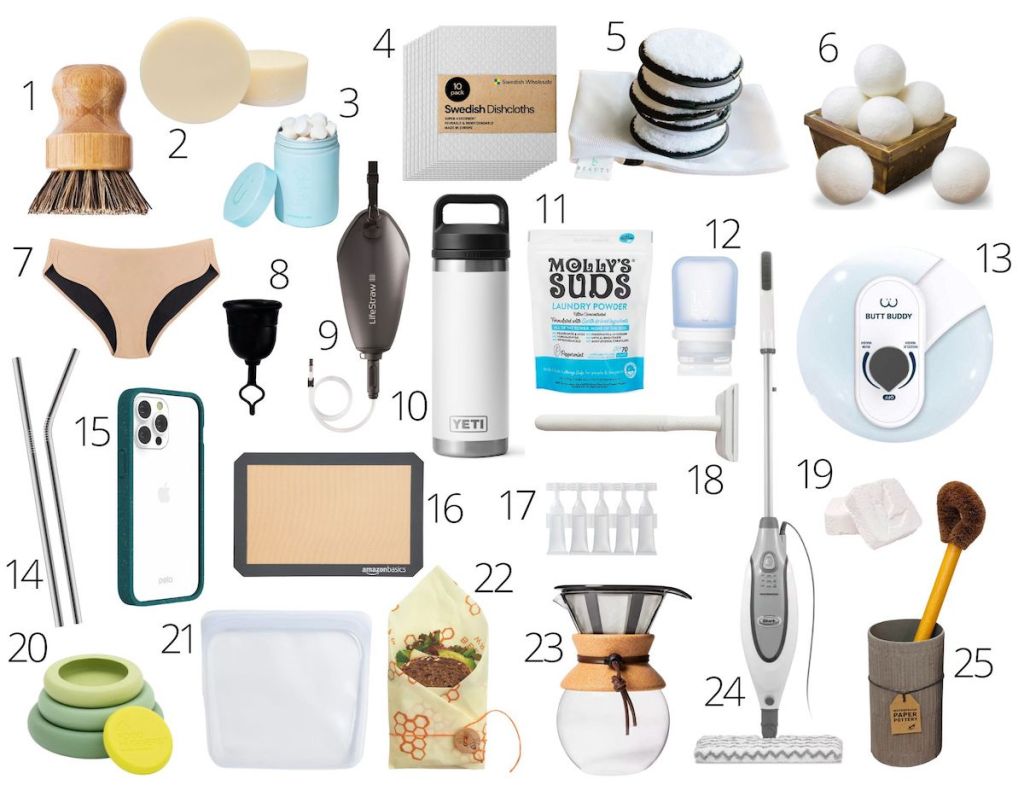
- Wooden dish brush
- Dish soap bars & Shampoo bars
- Toothpaste Tablets
- Swedish dishcloths
- Reusable makeup remover pads
- Wool dryer balls
- Period panties
- Menstrual cup
- Reusable water filter system
- Reusable water bottle
- Molly’s Suds natural laundry detergent
- Reusable silicone travel bottles
- Bidet
- Reusable straws
- Pela compostable phone case
- Silicone baking mats
- Force of Nature cleaner
- Bareaya razor
- Toilet bombs
- Food huggers
- Stasher reusable silicone bags
- Bees food wraps
- Pour-over brewer
- Steam mop
- Paper Pottery Holder and toilet brush
*Read below for how much each one can save you over the next 10 years and how your switch will impact the Earth!💰💸
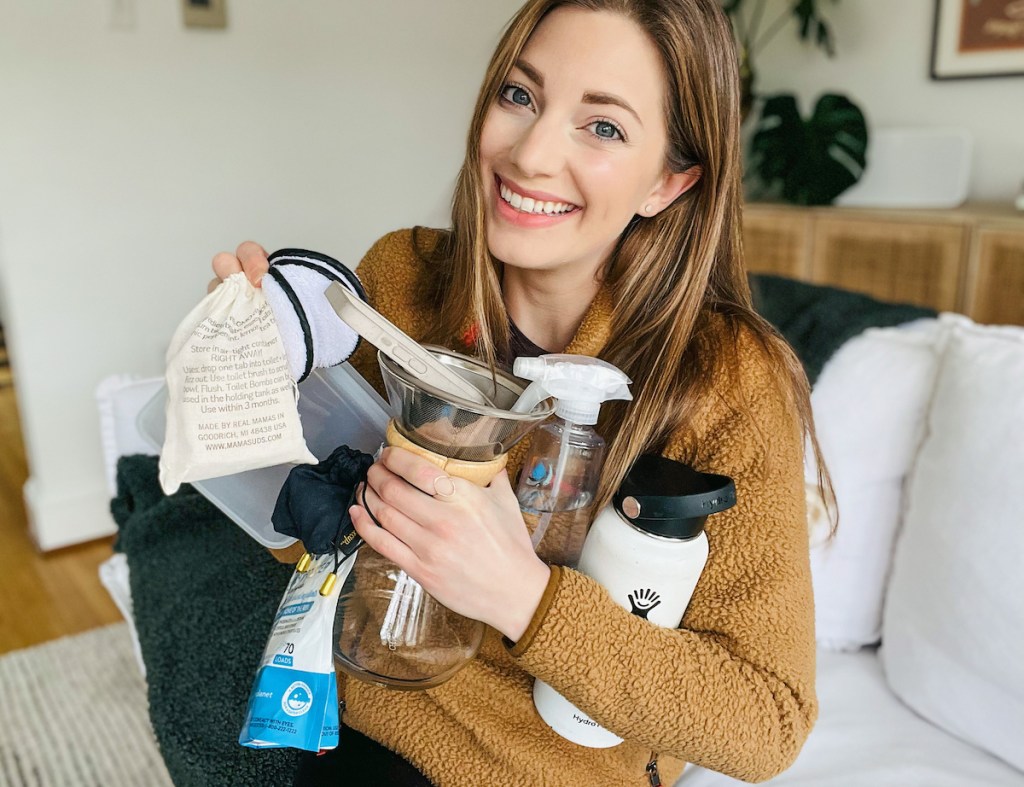
Important note:
Hey, Hipsters! 👋🏼 While I hope this post encourages you to make some positive changes for your home and your wallet, I wanted to remind you that choosing to become more sustainable and eco friendly is a process. Rome wasn’t built in a day and neither was a sustainable home. 😉 So while our list of swaps may feel cumbersome right now, remember lots of small changes over time create BIG, long-term results. Also, everything is difficult before it becomes easy so remember that you can only make these changes if you want to. ✌🏼 – ❤️ Sara, author & Hip sidekick
“Be the change you wish to see in the world.” – Mahatma Gandhi
On another note, the best thing you can do to become truly sustainable and eco friendly is to shop locally. Specifically at a zero-waste store if you have one available to you. Places like this will allow you to ditch tons of unnecessary packaging. Oftentimes, you can fill many household products and foods using the same containers from spices to soaps!
Check out how these reusable products and sustainable products will make a HUGE impact on you, your home, and the planet:
Ditch parchment paper, non-stick sprays, and aluminum in favor of silicone baking mats.
According to Statista, 318.97 million Americans used aluminum foil just in 2020. Producing just 1 ton of aluminum foil takes about 170 million BTUs to produce which is about as much as 1,400 gallons of gasoline. The process also emits about 12 tons of greenhouse gases and takes 400 years to break down after it’s discarded.
The average family is likely to use a standard-size roll of Reynolds Wrap in about a month or less. At $4.69 a roll (or more for larger rolls) you’re spending around $56.58 a year on aluminum foil. By switching to silicone baking mats, you’ll have a sanitary and simple way to cook all your meals and they’re dishwasher safe! Plus, they can even replace any parchment paper making the savings even greater.
If you get in the habit of using silicone baking mats, you’ll save 24,000 sq. ft. of foil and $565.80 over the next 10 years! 🎉
Hip Tip: Still find yourself using aluminum? Not to worry, aluminum foil is endlessly recyclable and can be rinsed and put in your curbside bin or taken to a local recycling facility.
Swap plastic straws for reusable straws.
Approximately 500 million straws are used each day in America alone! In fact, there are environmentalist beliefs that by 2050 there will be more weight in straws than fish in the oceans. The same was even quoted in The World Pursuit’s article about the importance of being eco-friendly. That’s only 28 years away, friends. 😱
A few years ago a lot of huge companies started nixing plastic straws including Starbucks. If you have a family of 5 that uses just 1 straw per week, that’s 260 straws a year! 😱 By switching to a reusable straw, you’ll be helping save our oceans and your hard-earned cash. Plus, these sustainable products come in many forms like silicone (safer for your teeth), stainless steel, and even bamboo!
If you and your family get in the habit of using reusable straws, you’ll nix about 2,600 plastic straws over the next 10 years! 🎉
Hip Tip: Shop our top highly-rated picks for all our favorite reusable straws.
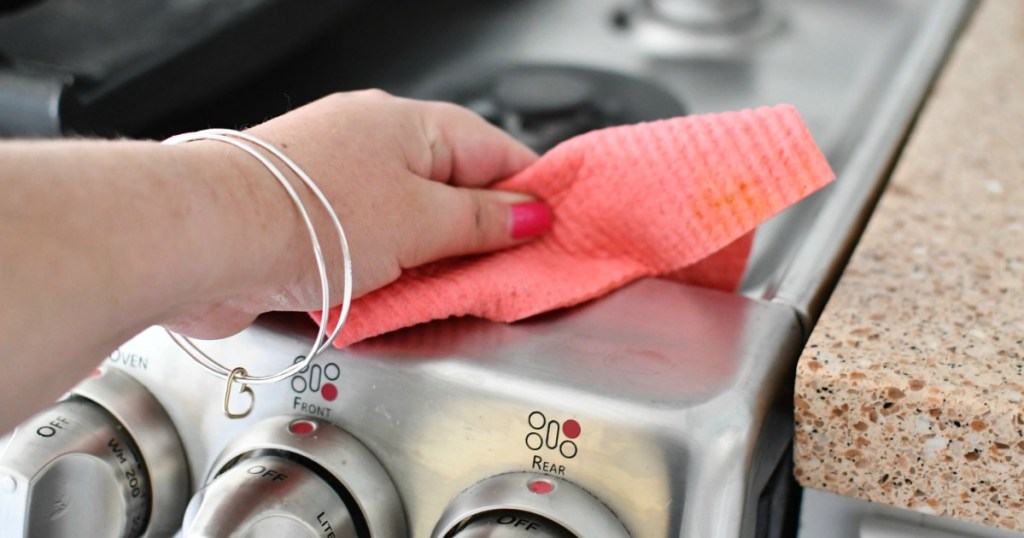
Paper towels are a waste of money, so hop on the Swedish dishcloth trend with us!
Ditching paper towels may be a big adjustment for many people, but they’re an even larger culprit to waste in our country. According to CottageCare “More than 13 billion pounds of paper towels are used each year in the USA. This means that every day more than 3,000 tons of paper towels are wasted in the U.S. alone.” 😱
If every household in the U.S. used just three fewer rolls of paper towels per year, it would save 120,000 tons of waste and $4.1 million in landfill dumping fees.
A 12-pack of Bounty paper towels will run you over $33.92. If you have a family of four, statistics show that you’ll power through them in three weeks or less! 😳
Swedish dishcloths are biodegradable, useful on many different surfaces, reusable, and easy to clean by throwing them in the dishwasher or washing machine!
If you and your family get in the habit of using an environmentally-friendly alternative to paper towels, you’ll save 3,200 rolls or about $4,070.40 or more over the next 10 years! 🎉
Hip Tip: There are even more alternatives to consider, such as reusable and washable bamboo paper towels, Zap cloths, microfiber cloths, bar mops, and even some new cloth diaper inserts.
Skip drying sheets, and toss in a wool ball instead.
As EWG states, dryer sheets are “full of chemicals that can harm your health, damage the environment, and pollute the air, both inside and outside your home.” Plus, most users tend to pop more than just one sheet (natural or not) in the dryer just for good measure.
If you’re using 2 dryer sheets for 5 loads of laundry a week, you’re using an entire box of these dryer sheets in just 10 1/2 weeks. So you’re spending about $40 every year and adding to the toxic waste problem.
You can grab wool dryer balls at an affordable price and they’ll last upwards of 1,000 laundry loads or until they fall apart. Dryer balls also help decrease your drying time, they’re biodegradable, dye-free, non-toxic, and don’t contain any harmful fragrances. You can also opt to use nothing at all and save your cash altogether.
If you get in the habit of using dryer balls, you’ll save 5,250 dryer sheets or about $400 over the next 10 years! 🎉
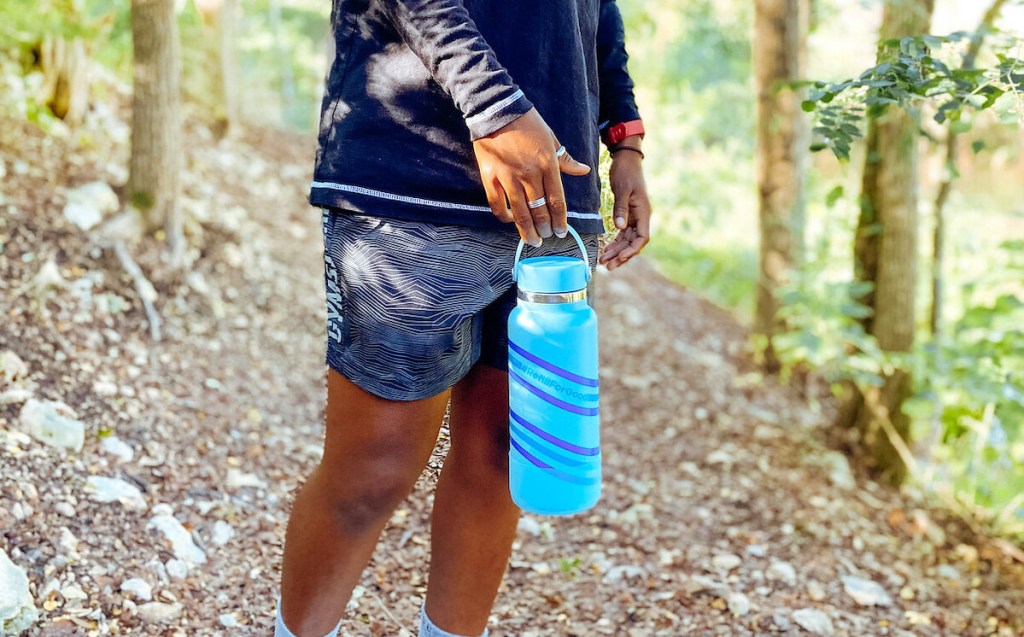
Switch out plastic water bottles for refillable ones instead.
Don’t stop drinking water, just stop drinking it out of plastic. Bottled water is ranked the #1 U.S. beverage by volume sold. According to the Container Recycling Institute, “more than 60 million plastic bottles end up in landfills and incinerators every day – a total of about 22 billion last year.” 😳
The average family currently spends about $100 per person each year on bottled water. That’s about 540 bottles per person or 2,160 bottles for a family of 4 per year down the drain – literally. By investing in a great water bottle that you can reuse every day, you’re not just saving money, but also helping mother nature, too.
Heading outdoors for some adventures? The LifeStraw Peak Gravity Water Filter System can provide 3 liters of clean water per minute. It removes silt, sand, and cloudiness greater than 0.2 microns. It also filters 99.999999% of all bacteria, such as salmonella, cholera, and E.coli, and removes 99.999% of all parasites and 99.999% of microplastics. Essentially, it’s perfect for any backpacking, hiking, or camping trip. Plus, these sustainable products by Lifeproof are leakproof and durable enough to last a lifetime.
If you and your family get in the habit of using reusable bottles, you’ll save 21,600 bottles of water or $4,000 over the next 10 years! 🎉
Swap plastic baggies for reusable wraps and silicone bags!
The number of plastic sandwich baggies I was frivolously using occurred to me when all 3 of my kiddos were in school. Every day, I was using at least 3 baggies per lunch! 😱 That’s 45 sandwich bags in just one week and not including the other bags I was using when it was convenient. That’s about 4 boxes of these Ziploc sandwich bags per month! If I stayed on that track, I was projected to spend about $253.92 or more just on baggies each year that had a lifespan of fewer than 24 hours. 😳
We completely switched to Stasher Bags over three years ago and haven’t looked back. They’re 100% silicone, easy to open and close, freezer and microwave-safe, and sous vide-safe. Plus, they’re even oven-ready and can even be thrown in the dishwasher for hassle-free cleaning! They’re endlessly reusable, extremely durable, and come in any size you need.
Bee’s Wraps are another sustainable product you can switch to. They’re naturally antimicrobial, made from GOTS-certified organic cotton, sustainably sourced beeswax, organic jojoba oil, and tree resin. All of the ingredients combined create a malleable and easy-to-use food wrap that can be used over and over again! 🙌
If you and your family get in the habit of using reusable wraps or Stasher Bags, you’ll save roughly 21,600 plastic sandwich bags and $2,539.20 over the next 10 years! 🎉
Hip Tip: Read more about why we love Stasher bags and Bees Wraps or if you’re more into DIY make your own at home!
Ditch your old kitchen sponge and replace it with a brush.
Did you know that the sponge is considered the germiest item in your kitchen according to the NYU School of Medicine? And you’re more likely to get food poisoning from an unsanitary sponge in your home than in a restaurant. 😱 It’s recommended to replace your sponge every 2-3 weeks. If you’re replacing your sponges every 2.5 weeks (on average) and buying a 3-pack of these sponges, you’re spending approximately $29 every year.
A wooden dish brush is your most sustainable product choice to swap to, but they also make some with an efficient soap dispenser that’s even dishwasher-safe! 🙌🏻
If you get in the habit of using a dish brush, you’ll save 208 sponges and $290 over the next 10 years! 🎉
Switch out the plastic wrap for silicone stretch lids or food huggers instead.
According to National Geographic, the average family goes through close to 10 rolls of plastic wrap per year! That’s about $55 per year just for plastic wrap and a huge waste of money when there are more sustainable products on the market.
Silicone stretch lids are perfect for storing leftovers, covering odd-shaped bowls or ones that don’t have lids, and they work a heck of a lot better than plastic wrap. They’re also conveniently dishwasher safe, BPA free, non-toxic, keep food fresher for longer, and reduce your household waste (obviously 😏).

Try Food Huggers as another alternative for your fruits and veggies! They’re perfect for those half-eaten foods or tiny jars you never know what to do with. Simply slip these innovative silicone covers on and you have an easy way to preserve foods you may have thrown out otherwise. Yay, for even more savings! 👏🏻
If you get in the habit of using silicone stretch lids and/or Food Huggers, you’ll be saving about 48,000 sq. ft. of plastic wrap or $598.80 over the next 10 years! 🎉
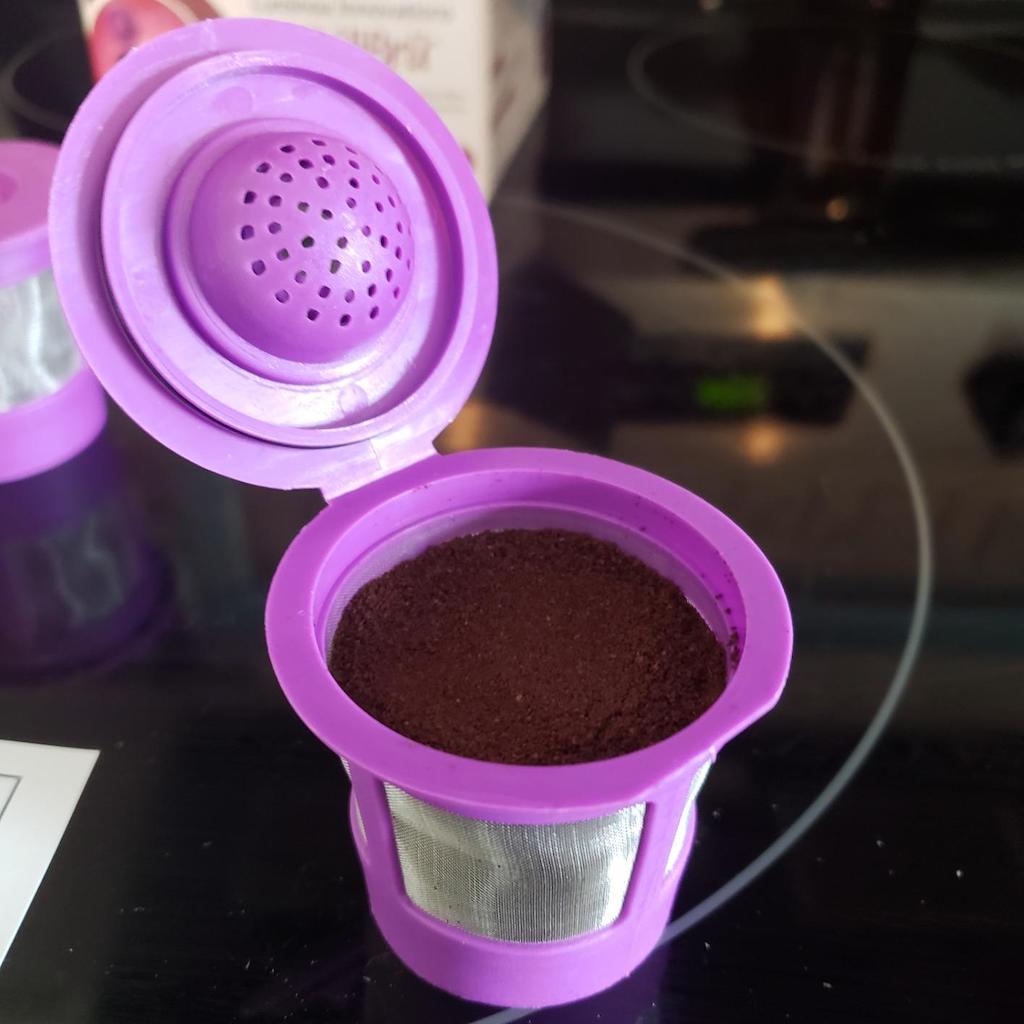
Keurig K-Cups are terrible for the planet, so switch to reusable cups or opt for a pour-over coffee maker instead.
The number of K-Cups that have been trashed in landfills could wrap around the planet 10 times and those stats are at least a few years old! 😱 If you and your spouse are brewing a cup of coffee with the Keurig every day, that’s 728 K-cups a year. Or about 33 of these boxes of Starbucks’ K-cups – priced at $17.99 each that’s $593.67 a year. 😳
If you don’t want to kick the convenience of your Keurig to the curb, opt for reusable K-cup pods so you can still brew your favorite ground coffee blends.
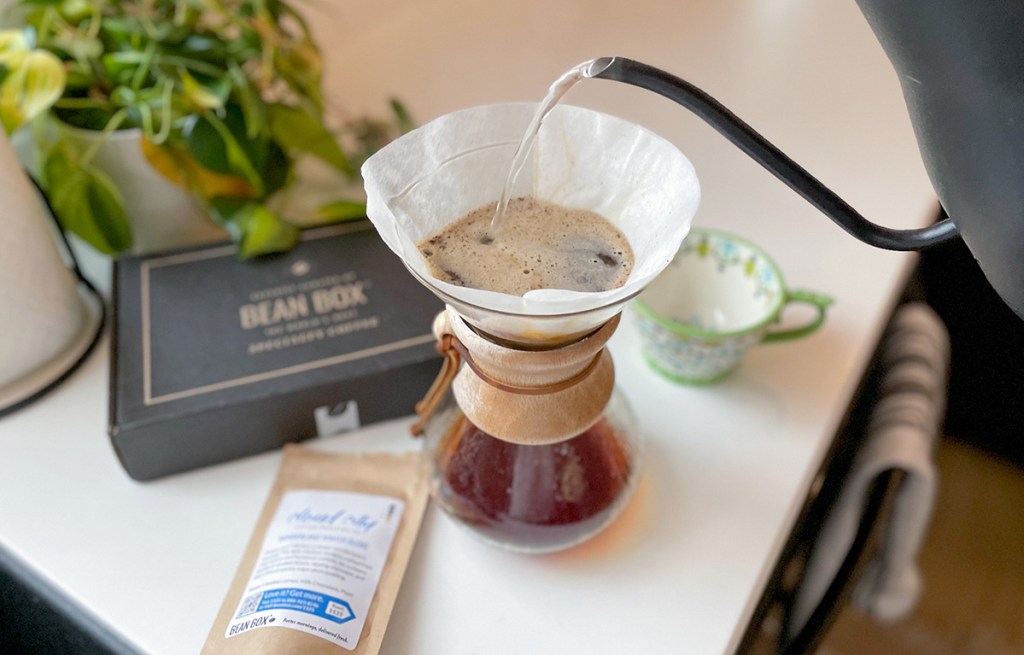
As another alternative, ditch the cups altogether and start making pour-over coffee. Target even offers a pour-over brewer that comes with a stainless steel filter. That means you won’t even be wasting paper filters to brew your steamy cup of coffee. 🙌 It’s how I enjoy coffee every morning and I’ve had the same set for over 3 years and counting!
If you and your other half get in the habit of using a reusable K-cup or pour over, you’ll save at least 7,280 disposable K-cups or $5,936.70 over the next 10 years! 🎉
Switch to makeup remover pads if you’re wasting wipes.
Those makeup wipes you’re using every morning and night are ending up in a landfill somewhere. In fact, according to Bustle, 7.6 billion pounds of wipes are thrown into landfills each year, which adds up to 1.3 billion wipes tossed each day. 😳 Plus, using just two a day from a popular pack will get costly at about $169.06 a year.
Make the switch to a reusable makeup remover that can be used endlessly. I’ve been using the Beauty by Earth Microfiber and Bamboo Makeup Remover Pads on rotation for years now. The microfiber rounds get a great lather and I love the bamboo ones for tougher jobs like mascara. I use my pads with micellar water which I’m able to refill at my local zero-waste store. However, there are also other sustainable products to consider like the Makeup Eraser which only requires water to work.
If you switch to reusable makeup remover pads, you’ll be projected to save about $1,690.68 over the next 10 years! 🎉
Hip Tip: Check out our favorite makeup removers.
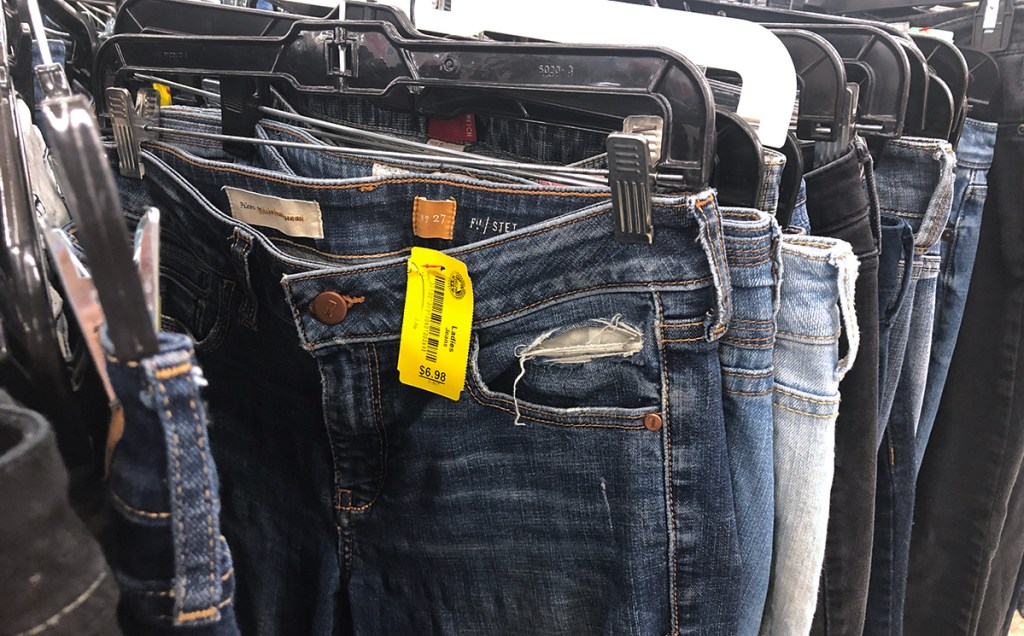
Don’t contribute to textile waste and buy secondhand clothing instead.
According to Earth.org, more than 100 billion garments are produced annually and the global emissions from it all are projected to increase by 50% by 2030. 😳 What’s worse, an estimated 11.3 million tons of textile waste ends up in landfills yearly just in America alone. That’s equivalent to approximately 81.5 lbs. per person, per year and around 2,150 pieces per second countrywide. 😱 It’s also ranked the 2nd biggest polluter of freshwater resources on the planet and accounts for 85% of the human-made material found along ocean shores, which is threatening marine wildlife and ending up in our food supply.
According to Credit Donkey, “the average family spends $1,800 per year on [new] clothing” with $388 of this on shoes. Adults (aged 25-34) spend an average of $161 per month on clothing and it increases by 26% for adults aged 35-44 with an average of $209 per month spent on clothes. 😱
If you and your family get in the habit of buying secondhand clothes, you’ll be projected to save $18,000 on new clothes over the next 10 years! 🎉
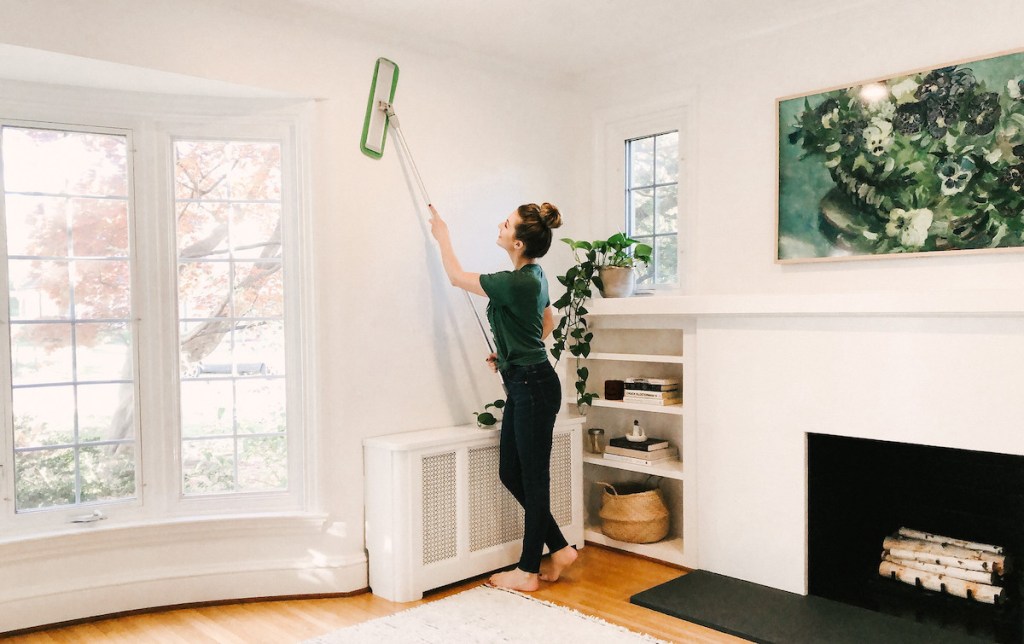
Ditch the Swiffer dry cloths and switch to reusable mop heads!
Have you ever thought about how much waste happens with regular Swiffer cleanings? If you’re averaging 2 dry pads a week, priced at $14.49 for 52, you’re spending over $28.98 a year or more just on Swiffer pads that’ll end up in a landfill. This doesn’t even include other cleaners or the multiple wet Swiffer pads you might use for deeper cleanings.
If you’re looking for an eco friendly alternative that’s even more effective, consider a Turbo mop. It happens to be made right here in the USA, can be used wet or dry, are reusable, and is machine washable. Plus, it can even be used on multiple surfaces like your walls! They even make reusable Swiffer pads (made by Turbo), so you don’t have to eat the cost of a new mop!
Need something for deeper cleanings? I’ve had a Shark Steam mop for over 4 years and can’t rave about it enough! The pads are endlessly washable and all you need to deep clean any floor is water! Put a few drops of essential oils on top and your whole house will smell amazing!
If you and your family get in the habit of using reusable mop cloths, you’ll be projected to save more than $289.80 over the next 10 years! 🎉
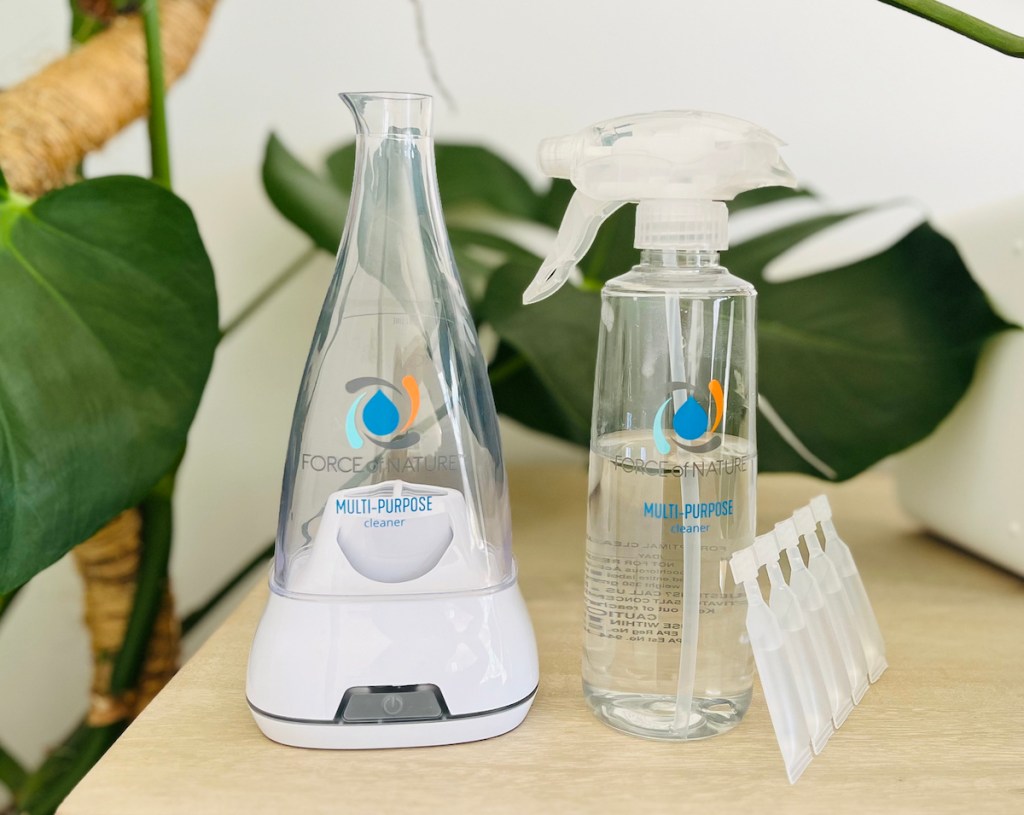
Use Force of Nature and ditch the toxic AND natural cleaners you’re already using.
Depending on what cleaners you’re using at home, they could be contributing to health problems according to the EPA. The Nest states that families, on average, are spending a whopping $600 every year for cleaning supplies. Not to mention, they’re likely horrible for the environment since many aren’t 100% biodegradable and contain chemicals.
However, even the most eco friendly products need to be replaced. So regardless if you’ve found the cleanest of them all, we have a better solution to minimize your waste altogether. AND it will cut your costs by at least 80%. 🙌🏼
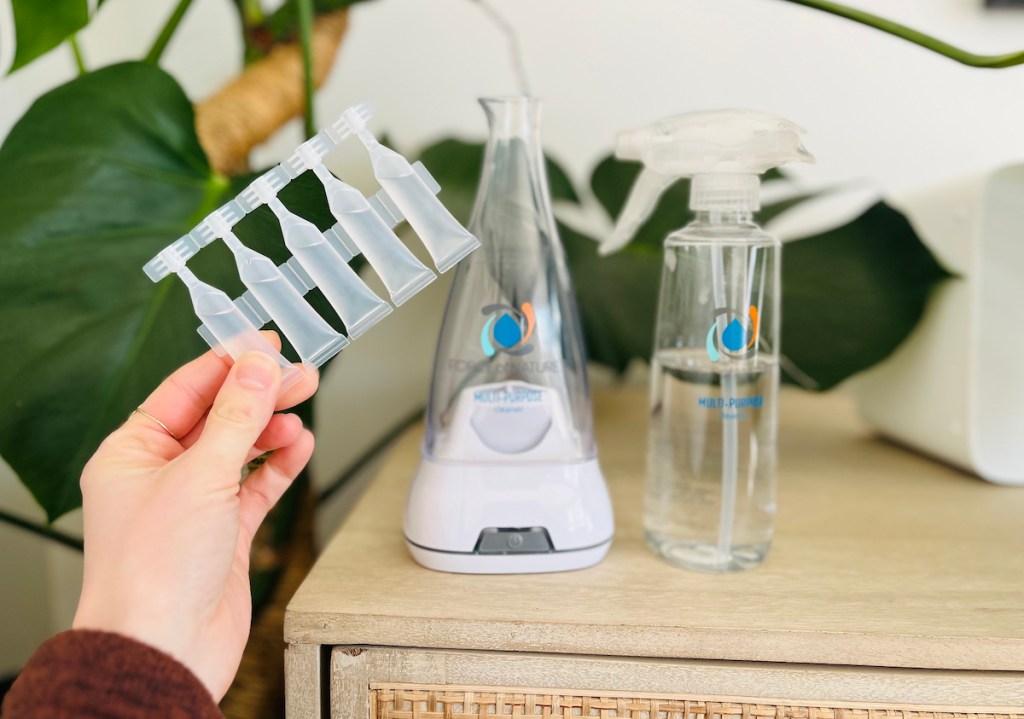
Force of Nature is a federal EPA-registered disinfectant and sanitizer that NATURALLY kills 99.9% of germs, bacteria, and viruses – even COVID. 😱 That’s right, it uses just water, salt, and vinegar and can be used to replace bleach, disinfectants, sanitizers, deodorizers, kitchen, bathroom, window, carpet, rug, floor, pet, sports, and baby product cleaners. 🤯 Needless to say, the savings potential is limitless.
What makes Force of Nature so unique is that it uses electricity to convert tap water plus a capsule of salt, water & vinegar into an organic multi-purpose cleaner and deodorizer. It’s a splurge up front but once you own this unique system, the refill capsules come out to just 9 cents per ounce 🤩 and completely eliminate single-use plastic bottles. Plus, the Recyclable Activator Capsules reduce plastic waste by 97%.
If you switch to using Force of Nature in your household, you’ll be projected to save about $4,800 or more over the next 10 years! Plus, you’ll save the planet from hundreds of plastic bottles too. 🎉

A menstrual cup will replace tampons and pads forever.
According to National Geographic, 5.8 billion tampons were sold in the U.S. in 2018, a third of the global total. Even more startling, when tampons are flushed down the toilet, they can end up in the ocean when sewer systems fail. Although plastic applicators from tampons are technically recyclable, they are usually not accepted for sanitary reasons making tampons a giant waste of money and terrible for the planet!
Before making my eco friendly products switch, I was personally spending over $10 every month on Tampax products. That’s more than $120 a year! Menstrual cups are game-changing. Since they’re 100% silicone, they’re completely safe for your body (unlike tampons), reusable, and easy to clean. Mine still looks brand new over three years later! 🤩 Even better, it pays for itself in just a couple of cycles! Not to mention, there are incredible benefits to wearing one as opposed to tampons and pads.
As another alternative, stop buying pads and stock up on period panties!

These aren’t just for post-partum mommies. In fact, any and every woman who gets their cycle can benefit from owning a few pairs of period panties. They’re a great backup to a menstrual cup or can absorb plenty of fluid on their own. Plus, they’re much more comfortable than a bulky or annoying pad. It’s essentially like wearing any other pair of panties, but with more peace of mind. 🙌🏻 Read my full review on the affordable Thinx period panties!
If you get in the habit of using a menstrual cup or period panties, you’ll be projected to save more than $1,200 over the next 10 years! 🎉
Use less toilet paper and be cleaner than ever with a bidet.
I certainly don’t expect your household to ditch toilet paper altogether, but you can cut back significantly. Incorporating a bidet into your bathroom routine will save you money and even possible sewage problems down the road. Plus, they have many other benefits too!
According to BidetsPlus, the average person uses 24 rolls of toilet paper per year! For a family of 4, you’re likely averaging 96 rolls or more per year. Priced at $25.49 per 30-pack of toilet paper, you’re easily spending close to $80 per year just to wipe! Of course, this can vary significantly with how much I know my kids waste every day.
While there are many expensive and more permanent bidets on Amazon, The Butt Buddy is a great option under $70. My boyfriend’s parents loved it so much they just bought a second one!
When a family of four incorporates a bidet in their daily lifestyle, it averages a savings of 80 rolls of toilet paper per year – which is a tenth of a tree! This means you’ll likely only need 16 rolls of toilet paper per year for 4 people! 😱 That’s a mere $17 on an Up & Up 18-pack that should last all year!
If you and your family get in the habit of using a bidet, you’ll be projected to save $652.80 or more over the next 10 years! 🎉
These sustainable products and eco friendly products may not save you a ton of money, but will be safer for your home and the environment:
Switch to toilet bombs and a sustainable and eco friendly brush for cleaning and ditch the disposable cleaning pads and toxic cleaners.
You’re not doing yourself or the planet justice if you’re using Clorox toilet wand refills or other chemicals to clean your toilets. Toilet bombs are a new switch we’ve made in our home and are much more sustainable and eco friendly products to be using. They’ll fizz in your toilet making it easy to clean and they’re made up of just a few ingredients – sodium bicarbonate, non-GMO citric acid, water, and essential oils. You could even make them yourself using HomeMadeLovely.com’s DIY to try and save money on this sustainable product swap.
Don’t forget to add an eco friendly cleaning brush to your new sustainable products regime. I love the Paper Pottery Holder because it’s ethically and sustainably made using recycled materials and is totally water-proof. Plus, the brush is made of coconut fiber which is anti-bacterial. So it will not become smelly or moldy like you’re old toxic plastic brushes. As a bonus, it’s cute and stylish too.
Shopping around? There are tons of eco friendly brushes on Amazon too!
Use a durable and reusable silicone bottle when you travel.
Humangear makes the best reusable silicone travel bottles. They’re a great eco friendly switch if you’re currently replacing small plastic bottles every time you travel. They’re available in various sizes and are made from durable FDA (food-safe) silicone. So, they’re perfect for virtually any lotion, soap, or whatever else you need to carry with you. They’re also TSA-approved and the lid can be easily converted into a loop so you can take them on every adventure. Plus, with their new and improved opening, they get out every last drop and they’re even easier to clean. 🙌🏼
Bar soap for your dishes and hair will save on plastic bottles and other toxic waste.
Consider replacing items you use daily like dish soap and shampoo with bar soaps. Switching to these eco friendly products will cut down significantly on plastic bottles and other toxic waste. Even better, if you can scoop up these sustainable products locally, they’ll likely come with no packaging at all making your carbon footprint nearly untraceable. If you don’t have a zero-waste store, there are a plethora of dish soap bars and shampoo bars to choose from on Etsy. I love used dish soap bars because they fit perfectly in a little dish and are convenient for me to use with my wooden dish brush.
Switch to a natural laundry detergent that is good for you, your home, and the planet.
After testing many natural detergents I landed on Molly’s Suds being one of the most sustainable products in the laundry detergent market. This USA-made detergent has just 5 Earth-derived ingredients and rates an “A” on EWG. Even the packaging is manufactured with sustainable sources and manufacturing and non-toxic inks. The cost of Molly’s Suds ends up being 21 cents per load and you’ll be saving the planet from various toxins and lots of plastic bottle waste.
Hip Tip: Check out all the natural laundry detergents I tested and what I liked and didn’t like about each one.
Toothpaste tablets will nix tubes altogether and are fun to use.
In the US, there are 400 million toothpaste tubes that end up in landfills every year, and 1.5 billion globally. What’s worse, they’re made from a combination of different plastics and often wrapped around a thin layer of aluminum making them nearly impossible to recycle. Toothpaste tablets naturally whiten, fight plaque, and freshen your breath while nixing tubes altogether. Even more exciting, they’re much quicker and cleaner to use if you struggle with kiddos leaving messy tubes in the bathroom. I love Huppy Toothpaste Tablets because they have very clean ingredients, my kids love them, and they’re conveniently available at my local zero-waste store.
Switch to a razor you’ll never have to replace.
According to many sources, a whopping 2 billion disposable razors are thrown away every year and aren’t even recyclable since they’re nearly impossible to separate the various commodities. One of my favorite sustainable products I switched to this year was my beloved Bareaya razor which has just one blade and is made of a brass and zinc alloy handle. It’s also incredibly durable so it can last a lifetime and the razors can be properly recycled. Overall, this razor will have a significant impact on your footprint, is minimal, efficient, and one of the best eco friendly products you could add to your daily regimen.

Grab a 100% biodegradable Pela phone case the next time you upgrade your tech.
According to Pela (and many other statistics), 1.5 BILLION phone cases are thrown away every year. Did you know it takes about 1,000 years for plastic to break down? And even then, they’re not gone forever since they become microplastics that end up in our precious oceans. Thankfully, Pela makes sustainable products that are changing the game. Plus, they minimize waste production by 80% and use 34% less water and 30% fewer carbon emissions.
Pela’s innovative phone cases are made from Flaxstick® and a plant-based biopolymer so they’re made from renewable sources and are 100% compostable. In fact, they can be left to break down in your very own home composting environment! 😱 What’s more exciting is that the purchase of 2 Pela phone cases is equivalent to saving the planet from 54 plastic bags being wasted. 👏🏻 I’ve had a Pela phone case for about a year and it’s definitely my favorite I’ve ever had!
Read more about Pela’s compostable phone cases and how to score the best deal.
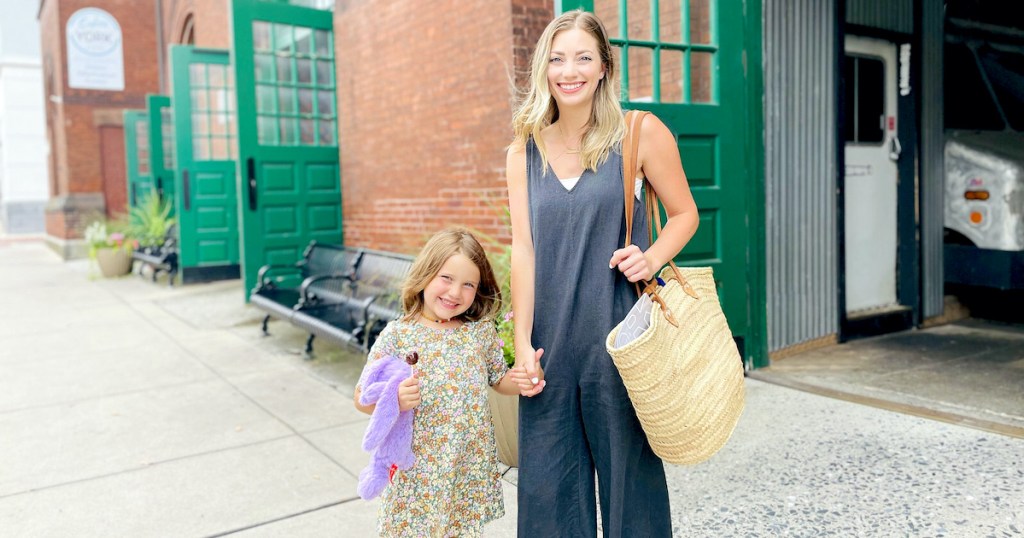
Bring a reusable bag every time you shop instead of using plastic.
Plastic bags are a huge contributing factor to our waste and on average a plastic bag is used for an average of just 12 minutes and less than 3% are recycled. 😳 According to the scary statistic shared by PADI, every second 160,000 plastic bags are used around the world. That’s 1 TRILLION bags a year and if we joined all the plastic bags in the world together, they would circumnavigate the globe 4,200 times! 😱

Thankfully, there are 8 states who have banned single-use plastic bags, but it’s crucial we start making the change too. Even better, some stores, like Target, Whole Foods, and Lowe’s (and more), will even give you a small credit on your purchase when you bring your own bags! While it’s typically only around 5-10 cents per bag, it will definitely add up over time and is just another perk of bringing your own eco friendly products.
If just one person used reusable bags over their lifetime, they would be removing about 22,000 plastic bags from the environment which is equivalent to $1,100-$2,200 on a 5-10 cent credit! 🙌
Hip Tip: This is my favorite reusable tote bag which you can personalize for FREE, has real leather straps, and is designed by independent artists!
If you’re still here, I hope you’re excited to become more eco friendly and sustainable in your home. ❤️
More importantly, you could potentially save a whopping $45,000+ over the next 10 years if you made many of our eco friendly swaps that could save you money! 😱😱
*Note that everyone’s family is different in size and these are just estimates based on our research and what the average person uses/buys for each of these products. The outcome or sum of savings can vary greatly and will depend on the cost of what you’re replacing these household items with.
!doctype>



